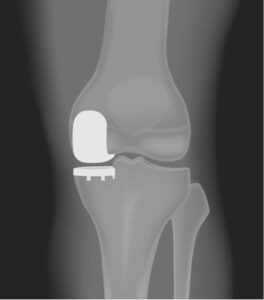Partial Knee Replacement Surgeon

Do you have knee pain that is isolated to the outer, inner or anterior portion of the knee? Have you been diagnosed as having an early osteoarthritis in one compartment of the knee? If so, you may be a candidate for a partial knee replacement or a unicompartmental knee replacement. Doctor Riley J. Williams provides diagnosis as well as surgical and nonsurgical treatment options for patients in Manhattan, Brooklyn, New York City and surrounding areas who need a partial knee replacement. Contact Dr. Williams’ team today!
Who is a candidate for partial knee replacement?
Patients who suffer from wear and tear arthritis (osteoarthritis) of the knee may be a candidate for partial knee replacement. The knee joint has three compartments: the lateral (outer), the medial (inner), and the anterior (patellofemoral). Arthritis is characterized by a loss of the articular cartilage at the ends of the thighbone (femur), lower leg (tibia) or kneecap (patella). The loss of articular cartilage results in pain and dysfunction in affected patients. Patients who have isolated arthritis in one of the three described compartments maybe a candidate for partial knee replacement. Dr. Riley J. Williams, orthopedic knee surgeon serving patients in Manhattan, Brooklyn, New York City, NY and surrounding areas has extensive experience and success in performing partial knee replacements.
What are the symptoms of patient who are candidates for partial knee replacement?
Patients who are possibly eligible to undergo partial knee replacement may have one or more of the following symptoms:
- Pain isolated to the inner, outer, or anterior knee
- Knee locking or catching
- Knee swelling
- Giving way or knee collapse
- Decreased capacity for walking or exercise
- Pain with deep squatting
How will Dr. Williams determine if I am eligible for partial knee replacement?
Dr. Williams will most likely be able to diagnose isolated knee arthritis with a physical examination. He will ask questions regarding your pain and when it began. He may gently pull and press on your knee or ask you to squat, jump or lunge to test your knee strength and pain level. Dr. Williams will also evaluate your knee stability and range of motion. He will obtain x-ray of the knee to check for joint space loss. An MRI is typically ordered to verify the isolated nature of the arthritic condition.
What is a partial knee replacement?
Partial knee replacement, also known as unicompartmental arthroplasty or partial knee resurfacing, describes a surgical procedure wherein the arthritic surfaces of the knee joint are covered with a thin metal implant. Most partial knee replacement are performed for isolated medial or lateral knee arthritis. The partial knee replacement procedure replaces the worn down cartilage surfaces of the femur and tibia with a size matched metal cover. A sturdy plastic insert is placed between the resurfaced femur and tibia, and acts as a new “meniscus”. A minimum of bone is taken during this procedure. The new surfaces of the partial knee replacement are smooth and restore frictionless joint motion. Unlike total knee replacement, the remaining structure of the knee are not impacted by the procedure. As a result, patient undergoing partial knee replacement significant pain relief, and report having natural feeling knees that perform well with normal and athletic type activities.
What is a unicompartmental arthroplasty?
Also called a partial knee replacement, unicompartmental arthroplasty is a surgical procedure that replaces only a portion of the knee that is affected by knee osteoarthritis. Unicompartmental arthroplasty is used to relieve the symptoms of arthritis when occurring in just one of the three compartments in the knee; the lateral, medial or anterior. Only a few, select patients are the best candidates for a unicompartmental arthroplasty. This procedure is very beneficial and can help patients avoid a complete knee replacement.
What is partial knee resurfacing?
Partial knee resurfacing is a surgical technique that addresses the effects of osteoarthritis in one compartment of the knee. It is an innovative treatment for adults with early osteoarthritis in either the medial (inner), Lateral (outer), or patellofemoral (top) compartments of the knee. During a partial knee resurfacing, Dr. Williams resurfaces the diseased portion of the knee, removing damaged tissue and preserving the healthy bone and surrounding viable tissue.
Partial knee resurfacing is done as a precursor to a partial knee replacement, or unicompartmental arthroplasty. Once Dr. Williams has resurfaced the compartment, he places an implant and secures it in the joint to allow the knee to glide smoothly again.
What can I expect following partial knee replacement surgery?
Partial knee replacement surgery is performed on an out-patient basis, meaning most patients are admitted for surgery and go home the same day. Regional and local anesthesia are the norm for this type of procedure. Assistive walking devices (crutches, cane) are used for 5-7 days, after which, patient may increase their weight bearing according to their tolerance. Physical therapy starts one week after surgery and continues for approximately 2 months following surgery. Cryotherapy should be used for the first month following surgery on a daily basis. Most patients report a full return to the activities of daily living by 6-8 week after surgery, and some return to sports by 12 weeks.
For more information on partial knee replacement, unicompartmental arthroplasty, and partial knee resurfacing, please contact the office of Riley Williams, MD, orthopedic knee specialist serving Manhattan, Brooklyn, New York City, NY and surrounding areas.
Locations
610 W 58th Street
New York, NY 10019
148 39th Street, 7th Floor
Brooklyn, NY 11232



